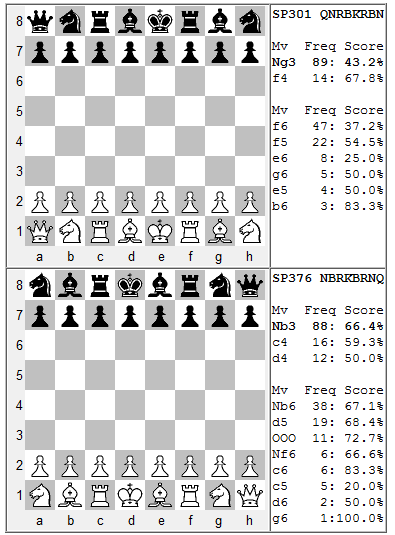The second pair of twins exhibiting widely varying success rates for White and Black were SP301 QNRBKRBN and SP376 NBRKBRNQ. The position SP301 had an average success rate for White (%W) of 47.0%, while SP376 had %W of 62.9. That means SP301 was more successful for Black, and SP376 more successful for White.
The following chart shows the two SPs next to the results collected from the CCRL's engine vs. engine data (once again, see the sidebar for a link to the CCRL data). For example, the data for SP301 says that the most popular move, 1.Ng3, was played in 89 games and had a 43.2% success rate for White (%W again). The second most popular move was only played in 14 games. I haven't listed the other first moves given by the CCRL for that SP, all of which were seen in less than 10 games. The second block of stats for SP301 shows all of the responses to 1.Ng3. The move 1...f6 was played in 47 of the 89 games and was largely responsible for the low %W.
The data for SP376 tells a different story. While 1.Nb3 (the logical counterpart of SP301's 1.Ng3) was again the most popular first move, the response 1...c6 (the counterpart to SP301's 1...f6) is further down the list. The top response to 1.Nb3 was 1...Nb6, a move whose SP301 counterpart 1...Ng6 is nowhere to be found. What's going on here?

As luck would have it, I've already discussed this pair of twins in another post: Watch out for ****KRBN. In SP301, after 1.Ng3, White is threatening a dangerous attack on g7. The most common opening sequence on CCRL was 1.Ng3 (x89 moves) f6 (x47) 2.f4 (x34) Ng6 (x19). Now there were three moves (total x22 due to transpositions), all played about the same number of times, and all with %W less than 50%. The worst of the three moves was 3.Nf5 with a score of +1-6=0, i.e. a disaster for White.
In SP376, after 1.Nb3 there is no attack on b7 because of the option to castle ...O-O-O. The most common opening sequence was 1.Nb3 (x88) Nb6 (x38) 2.c4 (x21), and now there were two moves more popular than 2...O-O-O (where White won all games). The first move was 2...g6, where the score was +1-7=0; the second was 2...Na4, with a score of +5-1=0. These scores, both disasters for different sides, make no sense to me. Perhaps they can best be explained by the small number of games played.
In both SPs, it appears that the side playing for the attack is 'playing to lose', as the old chess saying goes. I would love to investigate this further, but I'm afraid I've run out of time.

No comments:
Post a Comment